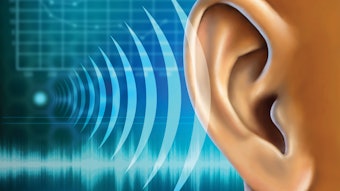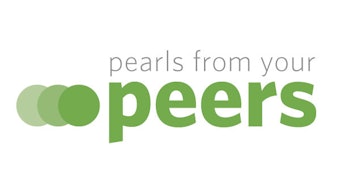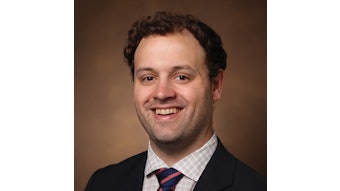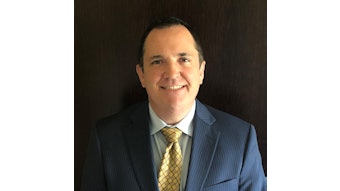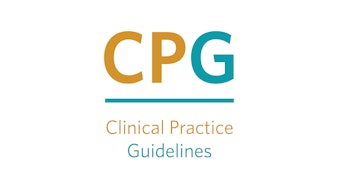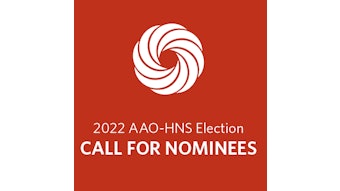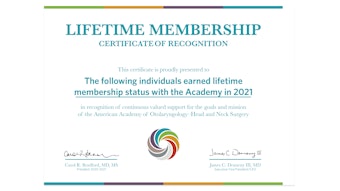New Video Series Explores Common Examples of Implicit Bias
AAO-HNSF, through the collaborative effort of the Diversity and Inclusion Committee, has created 10 interactive videos that explore the most common types of implicit bias. Written BY practicing physicians FOR physicians with real-world scenarios.
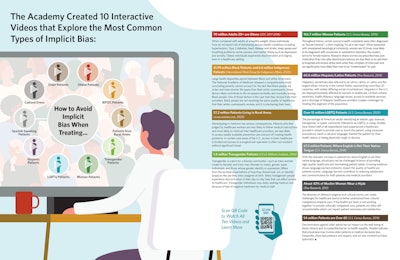
Click to view larger image
What is Implicit Bias?
Implicit bias is the unconscious collection of stereotypes and attitudes that individuals develop toward certain groups of people, which can affect patient access, relationships, care decisions and outcomes. Psychologists refer to implicit bias in healthcare as nonconscious or automatic feelings and beliefs about others that can result in subtle and overt signals affecting the patient experience and the care received.
Why did we produce this series?
The evidence that disparity in healthcare, which occurs on many levels, has been growing to the point that it is universally acknowledged as one of the most significant deficiencies of our current health system. One of the most significant factors identified is implicit bias within the medical team, which is correctable through education and training. Patients who have experienced implicit bias may leave an appointment with a negative and confused feeling, which leads to a lack of trust not only in the physician but in the treatment recommendations as well. These factors often result in the patient’s noncompliance; an outcome which can, in turn, shape a physician’s treatment decisions and a suboptimal end result. We feel that introducing this information to members of the healthcare team can significantly improve the current situation.
How was the series produced?
The Foundation, through the collaborative effort of the Diversity and Inclusion Committee, created 10 interactive videos that explore the most common types of implicit bias. Written BY practicing physicians FOR physicians, each video depicts two real-world scenarios—first an inappropriate interaction and then that same encounter repeated but free of implicit bias. After completing multi-level review, the scripts were sent to a professional production company that completed the project using professional actors after a thorough review and approval. Past President Duane J. Taylor, MD, provided the introductory video for the series.
Who can benefit?
As is graphically shown in this video series, all members of the healthcare team can benefit from a better understanding of and sensitivity to how implicit bias can present itself in patient care situations. We feel this can benefit physicians in the healthcare teams they work with in any setting where patients are seen, evaluated, and treated, including all outpatient and inpatient situations. We feel it is critical to disseminate this information as widely as possible. The series will be housed on the AAO-HNSF website and our Education platform OTO Logic and donated/distributed to all otolaryngology academic programs and to the American Board of Otolaryngology – Head and Neck Surgery. They will also be available for free download to our members and other interested parties. For all attendees at the Annual Meeting, the entire video series will be available through the Juno virtual meeting platform. We encourage you to show it to your office staff and other team members you regularly work with. You will be pleased with the benefits received.
The 10 New Interactive Videos that Explore the Most Common Types of Implicit Bias:
70 million Adults 20+ are Obese (CDC 2017-2018)
When compared with adults at a healthy weight, obese individuals have an increased risk of developing serious health conditions including hypertension; Type 2 diabetes; heart disease and stroke; sleep apnea and breathing problems; some cancers; and mental illness such as depression and anxiety. Obese individuals experience discrimination and stigma, even in a healthcare setting.
41.99 million Black Patients and 6.6 million Indigenous Patients (International Work Group for Indigenous Affairs, 2020)
Large health disparities persist between Black and white Americans. The National Academy of Medicine released a comprehensive study concluding poverty cannot account for the fact that Black people are sicker and have shorter life spans than their white counterparts. Many factors likely contribute to the increased morbidity and mortality among Black people. One of those factors is the care that they receive from their providers. Black people are not receiving the same quality of healthcare that their white counterparts receive, and it is shortening their lives.
57.2 million Patients Living in Rural Areas (www.statista.com, 2020)
Stereotyping in medicine has serious consequences. Patients who feel judged by healthcare workers are less likely to follow medical instructions and more likely to mistrust their healthcare providers, are less likely to access readily available preventive care and put off treating health problems. In certain rural areas of the U.S., access to basic healthcare is limited and access to a surgical sub-specialist is often non-existent without significant travel.
1.4 million Transgender Patients (UCLA Williams Institute, 2016)
Transgender is a term for a diverse community—such as trans women (male-to-female) and trans men (female-to-male), gender queer individuals, and those whose gender identity or expression differs from the societal expectations of how they should look, act, or identify based on the sex they were assigned at birth. Many transgender people experience discrimination in their day-to-day lives that can affect access to healthcare. Transgender individuals may delay seeking medical care because of fear of negative treatment by medical staff.
166.7 million Women Patients (U.S. Census Bureau, 2019)
Throughout history, certain women’s health complaints were often diagnosed as “female hysteria”– a term implying “it’s all in her head.” When presented with unexplained neurological complaints, women are 10 times more likely to be diagnosed with conversion or somatoform disorders, the modern terms for female hysteria. Research shows women are prescribed less pain medication than men after identical procedures, are less likely to be admitted to hospitals and receive stress tests when they complain of chest pain and are significantly more likely than men to be “undertreated” for pain.
60.6 million Hispanic/Latino Patients (Pew Research, 2019)
Hispanics, sometimes also referred to as Latino, Latina, or Latinx, are the largest ethnic minority in the United States, representing more than 20 countries, with widely differing social circumstances. Hispanics in the U.S. are disproportionately affected by barriers to healthcare. Limited cultural sensitivity, health illiteracy, language issues, access to available services, and a shortage of Hispanic healthcare providers creates challenges for treating this segment of the population.
Over 15 million LGBTQ Patients (U.S. Census Bureau, 2020)
The percentage of American adults identifying as lesbian, gay, bisexual, transgender, or queer, commonly referred to as LGBTQ, is rising. Studies have shown half of all respondents have experienced a healthcare provider’s refusal to provide care or touch the patient; using excessive precautions, harsh or abusive language; blamed the patient for their health status; or being physically rough or abusive.
67.3 million Patients Where English is Not Their Native Tongue (U.S. Census Bureau, 2018)
With the dramatic increase in patients for whom English is not their native language, physicians can be challenged in terms of providing high-quality healthcare and maintaining patient safety. Growing evidence shows language barriers indirectly impact the quality of healthcare patients receive. Language barriers contribute to reducing satisfaction and communication for both patients and medical providers.
About 43% of Muslim Women Wear a Hijab (Pew Research, 2011)
The diversity of different religions and cultural norms can create challenges for healthcare teams to better understand how cultural competence impacts care. If the healthcare team is not working together to provide culturally competent care, patients are often left uncomfortable which can impact patient outcomes and satisfaction.
54 million Patients are Over 65 (U.S. Census Bureau, 2019)
Discrimination against older adults has an impact on the well-being of those citizens and is a potential barrier to health equality. Studies indicate that physicians may involve older patients in medical decisions less frequently, show less patience and respect, and act less involved and less optimistic.
Additional Resources
Project Implicit: Explore and identify your own implicit biases by taking implicit association tests or through other means at https://implicit.harvard.edu/implicit/education.html.
The Joint Commission offers a free case example on health inequity and implicit bias at https://www.jointcommission.org/-/media/tjc/newsletters/case-example-no-5.pdf.

